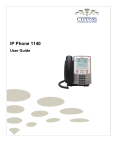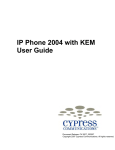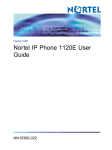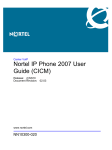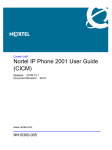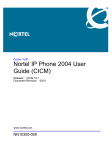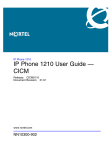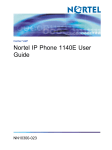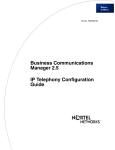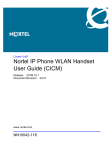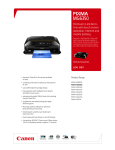Download Cypress VA1930WM VS11419 User's Manual
Transcript
IP Phone 1120 User Guide Copyright © 2007 Cypress Communications, Inc. All rights reserved. The information in this document is subject to change without notice. The statements, configurations, technical data, and recommendations in this document are believed to be accurate and reliable, but are presented without express or implied warranty. Users must take full responsibility for their applications of any products specified in this document. The information in this document is proprietary to Cypress Communications, Inc. Trademarks 2 • Nortel, Nortel (Logo), and the Globemark are trademarks of Nortel Networks. • The Cypress Communications logo is a service mark of Cypress Communications, Inc. • Cypress Communications is a trademark of Cypress Communications, Inc. IP Phone 1120 User Guide Contents Overview ........................................................................................................ 7 Key Features ...........................................................................................................7 Physical Features....................................................................................................8 Display.....................................................................................................................8 Indicators.................................................................................................................9 Connecting the IP Phone to the LAN......................................................... 10 Prerequisites .........................................................................................................10 Connecting the IP Phone to the LAN ....................................................................10 IP Phone connectors and other back panel features.........................................11 Getting Started ............................................................................................ 12 Logging on.............................................................................................................12 Logging off.............................................................................................................12 Using the dialpad to enter text...............................................................................13 Making, Answering, and Ending a Call...................................................... 14 Making a call using off-hook dialing ......................................................................14 Making a call using handsfree dialing ...................................................................14 Making a call using predial ....................................................................................14 Editing a predialed number ...................................................................................15 Answering a call ....................................................................................................15 Answering a second call........................................................................................15 Ending a call..........................................................................................................15 Using Phone Features ................................................................................ 16 Overview ...............................................................................................................16 Account Code........................................................................................................16 Authorization Code................................................................................................16 Automatic Dial .......................................................................................................16 Storing a number at an Automatic Dial key .......................................................17 Using an Automatic Dial key..............................................................................17 Copyright © 2007 Cypress Communications, Inc. All Rights Reserved. 3 Contents Busy Lamp Field (BLF) .........................................................................................17 Call Forward..........................................................................................................17 Call Hold................................................................................................................18 Conferencing (3-way or 30-way) ........................................................................... 18 Directed Call Park ................................................................................................. 18 Parking a call against a phone number ............................................................. 19 Retrieving a call parked against a phone number ............................................. 19 Directed Call Pickup..............................................................................................19 Answering a call with Directed Call Pickup........................................................ 19 Directory................................................................................................................19 Adding or editing a directory entry..................................................................... 19 Deleting an entry from the directory .................................................................. 20 Making a call using the directory ....................................................................... 20 Do Not Disturb / Make Set Busy ........................................................................... 20 Fast Transfer......................................................................................................... 20 Group Call Pickup ................................................................................................. 21 Picking up a call ................................................................................................ 21 Picking up a call while on a call ......................................................................... 21 Group Intercom ..................................................................................................... 21 Calling a member of your intercom group ......................................................... 21 Answering a Group Intercom call ...................................................................... 22 Paging a member of your intercom group ......................................................... 22 Paging all members of your intercom group...................................................... 22 Making a Conference call with your intercom group.......................................... 23 Inbox (Inbound Call Record) ................................................................................. 23 Accessing the Inbox .......................................................................................... 23 Viewing Inbox call information ........................................................................... 24 Storing a number from the Inbox ....................................................................... 24 Using the Inbox to make a call ..........................................................................24 Resetting the Inbox ........................................................................................... 25 Inspect................................................................................................................... 25 Intercom ................................................................................................................25 Last Number Redial .............................................................................................. 25 Multiple Appearance Directory Number (MDN)..................................................... 26 4 IP Phone 1120 User Guide Contents Making a Call on an MDN MCA or MDN SCA Key............................................26 Answering an MDN MCA or MDN SCA Call......................................................26 Transferring a MDN SCA Call to Another MDN SCA Group Member ...............26 Conferencing with a MDN SCA Line and Privacy Release ...............................27 Mute ......................................................................................................................27 Outbox (Outbound Call Record)............................................................................27 Accessing the Outbox........................................................................................27 Viewing Outbox call information ........................................................................28 Storing a number from the Outbox ....................................................................28 Using the Outbox to make a call........................................................................28 Resetting the Outbox.........................................................................................28 Speed Dial.............................................................................................................29 Storing a Speed Dial number ............................................................................29 Calling a Speed Dial number.............................................................................29 Voicemail...............................................................................................................29 Changing Your IP Phone Settings ............................................................. 30 Using the Settings menu .......................................................................................30 Using the navigation keys .....................................................................................30 Modifying Audio settings .......................................................................................31 Changing the default volume.............................................................................31 Resetting a default volume ................................................................................31 Selecting a ring tone..........................................................................................32 Modifying Feature key settings..............................................................................32 Relabeling a feature key....................................................................................32 Restoring default settings for a feature key .......................................................33 Adjusting the contrast level of the display .............................................................33 Selecting a language.............................................................................................33 Modifying Time settings.........................................................................................34 Navigating the Time menu.................................................................................34 Selecting the time zone .....................................................................................34 Enabling Daylight Saving Time..........................................................................34 Disabling Daylight Saving Time.........................................................................35 Setting the time format ......................................................................................35 Setting the date format ......................................................................................35 Resetting the default time..................................................................................36 Copyright © 2007 Cypress Communications, Inc. All Rights Reserved. 5 Contents Modifying User settings......................................................................................... 36 Navigating the User menu ................................................................................. 36 Viewing your user name .................................................................................... 36 Viewing your login type ..................................................................................... 37 Enabling or disabling the auto login feature ...................................................... 37 Changing your password................................................................................... 37 Performing a firmware upgrade............................................................................. 38 Access Code Summary...............................................................................39 6 IP Phone 1120 User Guide Key Features Overview Overview The IP Phone 1120 is a professional-level desktop phone that provides a full range of features with a large backlit display and fixed and programmable keys. The IP Phone 1120 brings voice and data to the desktop by connecting directly to a Local Area Network (LAN) through an Ethernet connection. You can use the handset and keypad of the IP Phone 1120 as you would use a standard telephone. You can access additional services through the soft keys positioned next to the display. The label beside each soft key identifies the feature associated with that key. Key Features • Up to four user-defined line/programmable feature keys and four soft label keys • High-resolution, fully-backlit, graphical, monochrome, eight-level grey scale, pixel-based (240x80) display • Five position (-5 to + 55 degrees) adjustable foot stand • Four-way navigation cluster with new Enter key • Integrated auto sensing 10/100/1000 Base-T Ethernet switch with shared PC access (one LAN and one PC port) • Secure local settings menu for access to user preferences, configuration tools, diagnostics and network statistics • Visual Alerting/ Message Waiting Indication and Feature Status Indicator LEDs • IEEE 802.3af Power over Ethernet, pre-standard vendor power schemes and local AC power options • Icon and English text-based keycaps • Field upgradeable firmware via Trivial File Transfer Protocol (TFTP) or Unistem File Transfer Protocol (UFTP) adds convenience and reduces costs in administration • Desk or Wall mountable • Graphite color with silver metallic bezel The diagram on the next page shows the location of the IP Phone 1120 keys and other components. Copyright © 2007 Cypress Communications, Inc. All Rights Reserved. 7 Overview Physical Features Physical Features Figure 1: Physical features Display The display on the IP Phone 1120 terminal has blue LED backlighting, which you can turn on and off. The backlight turns off automatically after a period of inactivity. Nortel IP Phone 1120 display has three distinct areas: • The upper area shows line and feature key status. • The middle area shows single-line information for items such as caller number, caller name, feature prompt strings, user-entered digits, date and time information, and telephone information. • The lower area displays the labels for the soft keys. The diagram on the next page identifies each section of the IP Phone 1120 display, showing the user-defined feature keys and the soft keys. 8 IP Phone 1120 User Guide Indicators Overview Figure 2: Display area features Indicators The IP Phone terminal uses light-emitting diodes (LEDs) of different colors to indicate the current state of the terminal. The following table describes each color and its associated state. A steady indicator means that the extension or feature beside it is active. A flashing indicator means the line is on hold or the feature is in the process of being programmed. Indicator LED color Meaning Message waiting Red (located at the top of the set) Lit when a message is waiting or a call is missed. The light turns off after you retrieve your message. Data waiting Blue (located at the top of the set) Lit when the terminal is on an active call. Handsfree Red (located on the front near the handsfree key) Lit when the handsfree feature is active. Headset Red (located on the front near the headset key) Lit when the headset is in use. Mute Red (located on the front near the mute key) Lit when the mute feature is active. The system administrator can configure the mute lamp to be steady on or blinking. Link/Data Green (located on the back cover near the network Ethernet jack) Lit when the link is alive and flashes to indicate activity. Copyright © 2007 Cypress Communications, Inc. All Rights Reserved. 9 Connecting the IP Phone to the LAN Prerequisites Connecting the IP Phone to the LAN Follow this procedure to connect the terminal to the Local Area Network (LAN) and to a power source. Prerequisites IP Phones can be powered by an AC adapter or over a LAN. Contact your installation technician to identify the correct power option. Warning: Risk of equipment damage Do not plug the IP Phone 1120 into a regular telephone jack. This causes severe damage to the terminal. Consult your system administrator to ensure that you plug your telephone into a 10/100BaseT Ethernet jack. Connecting the IP Phone to the LAN 1. Connect one end of the CAT-5 line cable to the LAN Ethernet port, identified with a LAN icon, located on the back of the terminal. 2. Connect the other end of the CAT-5 line cable to the IP network jack. For a terminal sharing LAN access with a PC, connect a second CAT-5 line cable to the PC Ethernet port located on the back of the terminal, identified by the PC icon. Connect the other end of the cable to the Ethernet port on the computer. 3. For a secure power connection, thread the cord around the strain relief, retaining hook, and channel on the back of the terminal. 4. Secure the terminal footstand to the terminal base. 10 IP Phone 1120 User Guide Connecting the IP Phone to the LAN Connecting the IP Phone to the LAN IP Phone connectors and other back panel features Figure 3: IP Phone connectors Copyright © 2007 Cypress Communications, Inc. All Rights Reserved. 11 Getting Started Logging on Getting Started Logging on Before you can use your IP Phone 1120, you must log on to obtain the features provided to you on the Cypress Communications network. You do not need to log on to your IP Phone 1120 every day. Your phone remains logged in unless you log out or your IP Phone loses power. You may be prompted to upgrade the IP Phone 1120 firmware before you log on. If this occurs, you must perform the upgrade before you can log on. For instructions, see "Performing a firmware upgrade" on page 38. Steps to take 1. At the Username screen, enter your user name. This is typically your complete 10-digit telephone number. If you make a mistake, press Clear to clear the field, and then enter the user name again. If your user name is too long for the display (longer than 15 characters), the digits scroll to the left and an ellipsis appears to the left of the user name. 2. Press the Ok key. The Password screen appears. 3. Enter your password. Your password is typically your four-digit extension + 99. For security, the password characters are displayed as asterisks (*). 4. If you make a mistake, press Clear to clear the field, and then enter the password again. 5. Press Ok. You are logged on and the Menu screen appears. Logging off Follow this procedure to log off from the network. 1. From the main menu, select Logoff. 2. Press Ok. A confirmation screen appears. 3. Confirm the action. You are logged off from the network. 12 IP Phone 1120 User Guide Using the dialpad to enter text Getting Started Using the dialpad to enter text Steps to Take 1. To enter text, find the number key associated with the letter you want to enter, and perform one of these actions: • To enter the first letter, press the key once. • To enter the second letter, press the key twice. • To enter the third letter, press the key three times. The letter appears on the display. 2. To enter special characters perform theses actions. See “Figure 4: Special Characters” for the list of special characters that are available. a. Press the Symbol soft key. A list of symbols opens. b. Scroll through the list and select the symbol. c. Press Ok, to enter the symbol. Figure 4: Special Characters Copyright © 2007 Cypress Communications, Inc. All Rights Reserved. 13 Making, Answering, and Ending a Call Making a call using off-hook dialing Making, Answering, and Ending a Call Making a call using off-hook dialing Follow this procedure to make a call using off-hook dialing. 1. Lift the handset from the cradle. The primary line is active and you hear a dial tone. 2. Use the dialpad to enter the number. 3. When the call is answered, begin speaking. Making a call using handsfree dialing Follow this procedure to make a call using handsfree dialing. See "Physical Features" on page 8 for the location of the handsfree key. 1. Press a line key. A line is selected and you hear a dial tone. 2. Use the dialpad to enter the number. 3. When the call is answered, begin speaking. 4. For privacy, lift the handset. 5. To return to handsfree mode, press the handsfree key and place the handset in the cradle. The handsfree feature is active. Making a call using predial Follow this procedure to use the predial feature to make a call. 1. Before you press a line key or lift the handset, use the dialpad to enter the number. The number is entered into the terminal. 2. When you want to make the call, press Ok. The number is dialed. 3. When the call is answered, begin speaking. 14 IP Phone 1120 User Guide Editing a predialed number Making, Answering, and Ending a Call Editing a predialed number Follow this procedure to edit a number held in the predialed state. Prerequisites A number must be predialed. 1. Perform one of these steps: • To delete numbers that appear to the left of the cursor, press Bkspc. • To delete numbers that appear to the right of the cursor, press Delete. 2. Use the dialpad to enter the new number. Answering a call • Perform one of these actions to answer a call: • Lift the handset. • To answer a call using the handsfree feature, press the handsfree key. • To answer a call while wearing a headset, press the headset key. Answering a second call Follow this procedure to answer a call when you are engaged in a call. If another call comes in while the primary line is engaged, the phone sounds and a message indicator icon on the display flashes. While the indicator is flashing you have the opportunity to put the first call on hold and answer the second call. 1. Press the hold key to put the active call on hold. 2. Press the line key for the second call. The call is answered. Ending a call • Perform one of these actions: • Return the handset to the cradle. • Press the Goodbye key. The call is ended. Tip: The Goodbye key is useful for dropping out of a conference call or exiting voicemail. Copyright © 2007 Cypress Communications, Inc. All Rights Reserved. 15 Using Phone Features Overview Using Phone Features Follow these procedures to use the features provided with your IP Phone 1120. Some of the features described may not be available to all users. Please see your system administrator if you require more information. Overview The IP Phone 1120 is operated using the fixed keys located on either side of the number dial pad , and feature/line keys that appear on display screen. To select a feature/line key find the feature on the display and then press the button next to it. If necessary, use the navigation button in the center of the phone to find the feature. Account Code Account Codes are codes that you can assign to a call for billing purposes. Steps to Take 1. Press the line key. 2. Press the Acct Code key (or star code *95). You will hear a stutter tone. 3. Enter your 13-digit account code. 4. When you hear the normal dial tone, dial your number to place your call. Authorization Code An Authorization Code is a numeric code that you enter to obtain access to long-distance or international telephone numbers. Steps to Take 1. Press the line key. 2. Press the Auth Code key (or star code *96) and then enter the Authorization Code assigned. You will hear a normal dial tone. 3. Dial the number to place the call. Automatic Dial Automatic Dial is a feature that allows you to store a frequently-used telephone number on a soft key. You can then press the key to dial the number. 16 IP Phone 1120 User Guide Busy Lamp Field (BLF) Using Phone Features If you use an Auto Dial key while you are on a call, your current call is placed on hold and your autodial call uses your secondary line. Storing a number at an Automatic Dial key Steps to Take 1. While the phone is on-hook, press the Auto Dial key. 2. Enter the desired number. 3. Press the Auto Dial key again. Using an Automatic Dial key Steps to Take 1. Press the line key. If you are already on a call, press your secondary line key. The current call is placed on hold. 2. Press the Auto Dial key to dial the number stored for the key. Busy Lamp Field (BLF) A Busy Lamp Field (BLF) is a soft key that displays the status of another telephone line (ringing, on-hook, off-hook). It is commonly used by receptionists who are responsible for transferring incoming calls from a single incoming line to multiple persons in an organization. BLF keys also provide for one-touch dialing and fast call transfer. It is not possible to answer an incoming call on a BLF key. A BLF key is a visual indicator only. A BLF key does not ring. To use a BLF key when transferring a call, see “Fast Transfer” on page 20. To use a BLF Key to fast dial a number: 1. Press the line key to obtain a dial tone. 2. Press the BLF key representing the number that you want to dial. Call Forward Follow this procedure to forward calls to another IP Phone when you are away from your desk. Steps to Take 1. To activate call forward without lifting the handset, press the Forward key. Copyright © 2007 Cypress Communications, Inc. All Rights Reserved. 17 Using Phone Features Call Hold 2. Use the dialpad to enter the extension to which you want to forward your incoming calls. 3. Press the Forward key again. An icon appears in the display next to the Forward key label. Calls will now be forwarded to the number that you entered. 4. To turn off call forward, press the Forward key. The feature is deactivated and the icon disappears from the display. Call Hold The Hold feature allows you to suspend a call without ending it. • To put a call on hold, press the Hold key. On the display, an indicator flashes next to the line on which the call is held. • To resume a call that is on hold, press the line key displaying the flashing hold indicator. Conferencing (3-way or 30-way) You can use Conferencing to include three or more calls in one phone conversation. The Three Way Call (3WC) feature allows you to add three calls to a conference. If you have been provided with the 30-way Conferencing feature, you can include up to 30 calls in one conversation. Steps to Take 1. During a call, press the Conference key. The call is put on hold and you will hear a dial tone. On the display, an indicator flashes beside the line on which the call is held. 2. Dial the number of the person you want to add to the call. At this time, you can talk privately to the person you are adding to announce the conference. 3. Press the Conference key again to merge the calls. 4. Repeat steps 2 and 3 to add additional parties to the call if appropriate. If you make a mistake dialing, or a party does not want to be included in the conference, press the line key of the conference call to reconnect to the conference. Directed Call Park You can use Directed Call Park to park a call at another number within your organization. Another person can then use Directed Call Park to retrieve the call by referring to this number. When a call is parked, the caller hears music or a message (or silence if these have not been configured.) A recall timer starts. If the call is not retrieved before the timer expires, the call rings back to the station that parked the call. If this station is busy, the timer restarts. 18 IP Phone 1120 User Guide Directed Call Pickup Using Phone Features Parking a call against a phone number Steps to Take 1. While on a call, press the Dir Park key. 2. Dial a number within your organization. The call is parked at that number. Retrieving a call parked against a phone number Steps to Take 1. Press the line key. 2. Press the Dir Park key. 3. Dial the number at which the call was parked. Directed Call Pickup Directed Call Pickup is a feature that allows you to answer a call ringing on another extension when you are both assigned to the same Call Pickup group. Answering a call with Directed Call Pickup Steps to Take 1. Press the Pickup key. 2. Dial the extension of the ringing phone. Directory You can use your IP Phone’s Directory to build a contact list containing your important telephone numbers. Each Directory entry consists of a name and a number. You can make a call directly from the Directory, or you can assign a Directory entry to an Autodial soft key. Adding or editing a directory entry Follow this procedure to add an entry to the directory. See "Physical Features" on page 8 for the location of the directory key. If you are unfamiliar with how to use the dialpad to enter text, see “Using the dialpad to enter text” on page 7. Copyright © 2007 Cypress Communications, Inc. All Rights Reserved. 19 Using Phone Features Do Not Disturb / Make Set Busy Deleting an entry from the directory Follow this procedure to delete an entry from the directory. See "Physical Features" on page 8 for the location of the Directory key. Steps to Take 1. Press the directory key to access the directory menu. The directory opens. 2. From the directory list, select the name you want to delete. 3. Press Ok. The Directory menu opens. 4. Press the down navigation key until the Delete option appears. 5. Press Ok. A confirmation screen appears. 6. Press Ok, and then press Yes to confirm the action. Making a call using the directory Follow this procedure to make a call from within the directory. See "Physical Features" on page 8 for the location of the Directory key. Steps to Take 1. Press the directory key to access the directory menu. 2. From the Directory list, select the name or number that you want to call. 3. Press Ok. The Dial screen appears. 4. Press Ok. The number is dialed. Do Not Disturb / Make Set Busy Use the Do Not Disturb feature to send calls directly to your voicemail box. • Press the Make Busy key. Any incoming calls will be routed to your voicemail. Fast Transfer You can use the Fast Transfer feature to quickly transfer a call to another party. You can announce the call before completing the transfer, or transfer without an announcement. Steps to Take 1. During a call, press the Fast Xfer key. The call is put on hold and you will hear a dial tone. On the display, an indicator flashes beside the line on which the call is held. 20 IP Phone 1120 User Guide Group Call Pickup Using Phone Features 2. Use the dialpad to enter the number to which to transfer the call. If your IP Phone includes a BLF key for the number that you wish to transfer to, you can press the BLF key instead of dialing. 3. When the number rings or is answered, press the Fast Xfer key again. The call is transferred. 4. If the call is not answered, press the line key to resume and terminate the call. Group Call Pickup If you are a member of a call pickup group, use Group Call Pickup to answer a call ringing at any extension in the group. Picking up a call Steps to Take 1. While a phone is ringing in your call pickup group, press the line key. 2. Press the Pickup key. 3. Dial the extension that is ringing. Picking up a call while on a call Steps to Take • While a phone is ringing in your call pickup group, press the Pickup key. Your current call is placed on hold and you retrieve the incoming call. Group Intercom You can use Group Intercom to call or page individual members of your intercom group using a short intercom number assigned to each member of the group. You can also page all intercom group members simultaneously, or establish a conference call with up to 30 members of your intercom group. Intercom numbers may be one, two, or three digits in length, depending upon the size of your intercom group. Contact your administrator to learn which intercom numbers have been assigned to your group. Calling a member of your intercom group Steps to Take 1. Lift the handset. Copyright © 2007 Cypress Communications, Inc. All Rights Reserved. 21 Using Phone Features Group Intercom 2. Press the Grp Intrcm key. 3. Dial the desired intercom number. If you are on a call, the call is placed on hold. Answering a Group Intercom call When you receive a Group Intercom call, your phone rings or a tone sounds if you are already on a call. Your Grp Intrcm key display flashes. 1. Lift the handset. 2. Press the Grp Intrcm key to answer the call. If you are on a call, your current call is placed on hold. Paging a member of your intercom group 1. Lift the handset. 2. Press the Grp Intrcm key. 3. Dial the desired intercom number. 4. When you hear ringing, press the Grp Intrcm key again. This activates a one-way speaker in the telephone of the person you called. If the person you called is already on the phone, her phone speaker is not activated, but the Grp Intrcm key flashes. She must press the Grp Intrcm key to answer your call. 5. Speak your announcement. 6. To end the call, press the Goodbye key and replace the handset. Paging all members of your intercom group 1. Lift the handset. 2. Press the Grp Intrcm key. 3. Press #. 4. When you hear ringing, press the Grp Intrcm key again. This activates a one-way speaker in the each telephone in your intercom group. If any group member is on the phone, her phone speaker is not activated, but the Grp Intrcm key flashes. She must press the Grp Intrcm key to answer your call. 5. Speak your announcement. 6. During the page, any group member can lift the phone handset to respond. The member’s voice will be heard through all speakers in the intercom group. 7. To end the call, press the Goodbye key and replace the handset. 22 IP Phone 1120 User Guide Inbox (Inbound Call Record) Using Phone Features Making a Conference call with your intercom group Follow these steps to create a conference call with up to 30 members of your intercom group. Steps to Take 1. Lift the handset. 2. Press the Grp Intrcm key. 3. Press #. This calls each member of your intercom group, ringing their phone and flashing the Grp Intrcm key. As each person answers the call to enter the conference, you hear a short ring tone. When any member terminates the call to leave the conference, you hear the ring tone again. 4. To end the call, press the Goodbye key and replace the handset. The conference call ends for all members of your intercom group. Inbox (Inbound Call Record) The Inbox is a record of the last ten calls that you have received. Inbox records include the incoming phone number, time and date, as well as the display shown on the IP Phone at the time of the incoming call. A call record is saved in the Inbox only for calls that last for more than two seconds. The IP Phone 1120 has a dedicated fixed key for the Inbox. The Inbox can store a maximum of 10 calls. When the maximum is reached, the oldest call is dropped. Calls appear in the list in the order in which they were received, with the most recent call at the top of the list. The Inbox call display consists of a time or date stamp, and a name or number. A time stamp appears beside calls you receive on the same day on which you view the Inbox. A date stamp appears beside calls that arrive prior to the day of viewing. If no name or number was extracted from the display of the incoming call, a No Details message appears. If you have a message waiting or you have missed a call, the message waiting lamp is turned on. The lamp turns off after you check your Inbox or retrieve the waiting message. Accessing the Inbox Follow this procedure to access and use the Inbox. If you have a message waiting, the message waiting indicator lamp on the top right corner of the terminal is turned on. The light is turned off after you access the Inbox. Steps to Take 1. Press the Msg/Inbox key. The Inbox screen appears, showing a list of the 10 most recent incoming calls. Copyright © 2007 Cypress Communications, Inc. All Rights Reserved. 23 Using Phone Features Inbox (Inbound Call Record) 2. Select an item from the list and press Ok. 3. Perform one of these actions: • Select Dial to call the number. • Select Display to view caller information. • Select Store to store the number in the directory. Viewing Inbox call information Follow this procedure to view the information about a call in the Inbox. 1. Press the Msg/Inbox key. The Inbox screen appears, showing a list of the 10 most recent incoming calls. 2. Select a number from the list. 3. Press Ok. The Dial screen appears. 4. Press the down navigation key. 5. Select Display. The Display screen appears. 6. Press the down navigation key to view the information. Storing a number from the Inbox Follow this procedure to select a number from the Inbox and save it to the directory. 1. Press the Msg/Inbox key. The Inbox screen appears, showing a list of the 10 most recent incoming calls. 2. Select a number from the list. 3. Press Ok. The Dial screen appears. 4. Press the down navigation key to select Store. The directory submenu opens. See "Adding or editing a directory entry" on page 19. Using the Inbox to make a call Follow this procedure to make a call from within the Inbox. 1. Press the Msg/Inbox key. The Inbox screen appears, showing a list of the 10 most recent incoming calls. 2. Select the number you want to dial. 3. Press Ok. 4. Select Dial. 5. Press Ok. The Predial screen appears with the number entered in the display. 24 IP Phone 1120 User Guide Inspect Using Phone Features 6. Perform one of these steps. • To edit the number, see "Editing a predialed number" on page 15. • To make the call, see "Making a call using predial" on page 14. Resetting the Inbox Follow this procedure to empty the contents of the Inbox. 1. From the main menu, select and open the History menu. 2. From the History menu, select Reset Inbox. A confirmation screen appears. 3. Press Yes. The calls in the Inbox are deleted. You return to the previous menu. Inspect With Inspect, you can display information about feature keys such as Speed Dial or Auto Dial. You can also use Inspect to see caller ID information for incoming calls, such as calls on your secondary line. • To use Inspect, press the Inspect key and then press a feature key or line key. • If a call is ringing on the line key caller ID information is displayed for the call • If Inspect is applied to a Speed Dial or Auto Dial key, the number programmed for that key is displayed, Intercom Intercom provides a way for you to call a person in your organization with a single key-press. If that person is not already on a call, you can immediately begin speaking through their phone speaker. Making an Intercom call • Press the Intercom key. The phone number assigned to the key is dialed. Answering an Intercom call • When you receive an Intercom call through the speaker of your IP Phone, you can respond to the caller by picking up your phone handset. • If you receive an Intercom call while you are on a call, you will hear a tone. To answer the call and place your current call on hold, press the Intercom key. Last Number Redial To redial the last number that you called, press ## (the # key twice). Copyright © 2007 Cypress Communications, Inc. All Rights Reserved. 25 Using Phone Features Multiple Appearance Directory Number (MDN) Multiple Appearance Directory Number (MDN) Multiple Appearance Directory Number (MDN) is a feature that allows one phone number to appear on more than one IP Phone. In each MDN group, one number is designated as the primary, and one or more other users are designated as secondary group members. When a call is made to the primary number, the call rings on the primary phone and flashes and rings (unless set to non-ringing) on each secondary group member’s phone. If you are a secondary group member, you can then answer the call or place the call on hold. You can also make outbound calls using an MDN key. MDN is available in two forms: Multiple Call Appearance (MDN MCA) and Single Call Appearance (MDN SCA): • MDN SCA keys display the status (on-hook, off-hook) of the MDN SCA primary line; MDN MCA keys do not. • When a MDN SCA line is off-hook , no one else can make or receive calls on that line. When you use a MDN MCA line, others can still use that line, up to the number of available MDN MCA lines assigned to the MDN MCA group. A common application of this is to provide a way for an administrator to monitor and manage phone calls to their manager, or for a receptionist to manage calls to employees. In this situation, the manager or employee is designated as the primary MDN member, and the administrator or receptionist is designated as the secondary group member and is provided with an MDN key for each manager/employee. Another application for this feature is to form a simple call group, in which a call to a selected number (primary) can be answered by others designated as secondary group members. Making a Call on an MDN MCA or MDN SCA Key Steps to Take 1. Press the MDN MCA or MDN SCA key. 2. Dial the number that you want to call. Answering an MDN MCA or MDN SCA Call • When the MDN MCA or SCA key flashes and (if provisioned to ring) your phone rings, press the MDN MCA or MDN SCA key. If more than one line is ringing in the MDN group, you will answer the first incoming call. Transferring a MDN SCA Call to Another MDN SCA Group Member While you are on a call on the MDN SCA line: 1. Place the MDN SCA call on hold by pressing the Hold key. 2. Any available member of your MDN SCA group can now obtain the call by pressing their MDN SCA key. 26 IP Phone 1120 User Guide Mute Using Phone Features Conferencing with a MDN SCA Line and Privacy Release When you answer a call using an MDN SCA key, you can allow another join the call by using the Privacy Release key. • While in an MDN SCA call, press the PRL (Privacy Release) key. Another MDN SCA group member can now press their MDN SCA key to join the call. Mute You can apply Mute on your phone during a call to prevent the other party or parties from hearing you. • While on a call, press the Mute key to activate Mute and disable your telephone’s microphone. A red light on the Mute key flashes. • To turn off Mute, press the Mute key again. The Mute light is turned off, and your telephone’s microphone is activated again. Outbox (Outbound Call Record) The Outbox is a record of the last ten calls that you have made. Outbox records include the phone number called, the time and the date. A call record is saved in the Outbox only for calls that last for more than two seconds. The IP Phone 1120 has a dedicated fixed key for the Outbox. The Outbox can store a maximum of 10 calls. When the maximum is reached, the oldest call is dropped. Calls appear in the list in order in which they were made, with the most recent call at the top of the list. The Outbox call display consists of a time or date stamp and a name or number. A time stamp appears beside calls you make on the same day on which you view the Outbox. A date stamp appears beside calls that were made prior to the day of viewing. If no name or number was extracted from the display of the outgoing call, the number dialed appears. Use the navigation keys to scroll through the list. The list does not wrap around. Accessing the Outbox Steps to Take 1. Press the Shift/Outbox key. The Outbox screen appears, showing a list of the 10 most recent outgoing calls. 2. Select an item from the list and press the Ok key. 3. Perform one of these actions: • Select Dial to call the number. • Select Display to view caller information. • Select Store to store the number in the directory. Copyright © 2007 Cypress Communications, Inc. All Rights Reserved. 27 Using Phone Features Outbox (Outbound Call Record) Viewing Outbox call information Follow this procedure to view the information about a call in the Outbox. Steps to Take 1. Press the Shift/Outbox key. The Outbox screen appears, showing a list of the 10 most recent outgoing calls. 2. Select a number from the list. 3. Press the Ok key. The Dial screen appears. 4. Press the down navigation key. 5. Select Display. The Display screen appears. 6. Press the down navigation key to view the information. Storing a number from the Outbox Follow this procedure to select a number from the Outbox and store it in the directory. 1. Press the Shift/Outbox key. The Outbox screen appears, showing a list of the 10 most recent outgoing calls. 2. Select a number from the list. 3. Press the Ok key. A list of options appears. 4. Press the down navigation key to select Store. The directory submenu appears. See "Adding or editing a directory entry" on page 19. Using the Outbox to make a call Follow this procedure to make a call from within the Outbox. 1. Press the Shift/Outbox key. The Outbox screen appears, showing a list of the 10 most recent outgoing calls. 2. Select the number you want to dial. 3. Press the Ok key. 4. Select Dial. The number is dialed. Resetting the Outbox Follow this procedure to empty the contents of the Outbox. 1. From the main menu, select and open History. 2. From the History menu, select Reset Outbox. A confirmation screen appears. 3. Press Yes. The calls in the Outbox are deleted. You return to the previous menu. 28 IP Phone 1120 User Guide Speed Dial Using Phone Features Speed Dial If you have a list of phone numbers that you dial frequently, you can use the Speed Dial feature to store each telephone number. You can then dial any of these persons quickly by using their Speed Dial code instead of the full telephone number. Speed dialed numbers can be internal or external. Speed Dial codes can be between 20 and 39. Storing a Speed Dial number 1. Press the SpeedDial key. 2. Enter a Speed Dial call position from 20 to 39. 3. Enter the telephone number. 4. Press the SpeedDial key again. Calling a Speed Dial number 1. Press a line key or lift the handset of your phone. 2. Press the SpeedDial key. 3. Dial the Speed Dial position (20-39) for the telephone number. Voicemail To access your voicemail box, press the Voicemail key. For instructions, see your voicemail reference guide. Copyright © 2007 Cypress Communications, Inc. All Rights Reserved. 29 Changing Your IP Phone Settings Using the Settings menu Changing Your IP Phone Settings Using the Settings menu Follow these procedures to navigate and select items from the main menu. Menu items can be selected with a shortcut key. The shortcut key is the number on the dialpad that corresponds to the number of the menu item. Only items numbered 0 through 9 can be opened by a shortcut key. Use the navigation keys to scroll through menus and screens. Follow this procedure to open the main menu. 1. Press Menu, or press the Services key. The main menu opens. 2. To select an item in a menu, perform one of these actions: • Select the item, and then press the Ok key • Select the item, and then press the Enter key located at the center of the navigation keys. • Press the shortcut key corresponding to the menu item The selected menu opens. Using the navigation keys The IP Phone terminal has five keys that you use to navigate the menus, and to help you to enter text in the display. See "Physical Features" on page 8 for the location of these keys. 30 • Up key — Return to the previous menu item. • Down key — Go to the next menu item. • Left/Right key — Move the cursor to the left or right when entering text. • Enter key — Select the menu item or save the current setting IP Phone 1120 User Guide Modifying Audio settings Changing Your IP Phone Settings Modifying Audio settings You can change the following audio settings for your IP Phone: • Default volumes, or resetting volumes to preset default levels • Ring tone Changing the default volume Follow this procedure to change the default volume of the handset, headset, handsfree speaker, ringer, or buzzer. Steps to Take 1. From the main menu, select and open Audio. The Audio menu opens. 2. Navigate through the menu and select Default Volumes. A list of devices appears (Handset, Headset, etc.) 3. Select the device for which you want to change the default volume. 4. Press the Ok key. A volume adjustment screen appears. 5. Change the volume by using the right/left navigation keys: • Use the right navigation key to increase the volume. • Use the left navigation key to decrease the volume. 6. Press the Ok key to confirm the change. The selected volume is applied the next time the audio device is used. Resetting a default volume Follow this procedure to reset the default volume of the handset, headset, handsfree speaker, ringer, or buzzer. Steps to Take 1. From the main menu, select and open Audio. The Audio menu opens. 2. Navigate through the menu and select Default Volumes. 3. Select the device that you want to reset to the default volume. 4. Press the Ok key or the Enter key. The volume adjustment screen opens. 5. Press the Reset key. The volume is reset to the default level 6. Press the Ok key to confirm the action. The default volume is applied the next time the device is used. Copyright © 2007 Cypress Communications, Inc. All Rights Reserved. 31 Changing Your IP Phone Settings Modifying Feature key settings Selecting a ring tone Steps to Take 1. From the main menu, select and open Audio. The Audio menu opens. 2. Scroll through the menu and select Play Ring Patterns. The list of ring tones opens. 3. Scroll through the ring tones list to find the tone that you want. Press the Ok key to select a tone. 4. To hear a ring tone before you select it, select a ring tone from the list, and then: • Press the Ok key for the Play option to hear the tone. • To stop the tone, press Cancel, or scroll to the Stop option and press the Ok key. • Press Cancel to stop the ring tone from playing. 5. To select a ring tone, navigate to Apply in the menu for the ring tone, and then press the Ok key. Modifying Feature key settings Follow these procedures to use the Feature menu. When you access the Feature menu, a numbered list of the feature provisioned on each key is displayed. The number displayed indicates the key to which the feature is assigned. Features are assigned by your system administrator, but you can: • change the label for a feature. • restore the default settings for a feature. Relabeling a feature key Steps to Take 1. From the main menu, select and open the Feature menu. 2. Select the feature that you want to relabel by navigating to the item in the list, and then pressing the Enter key or the Ok key. 3. Select the Label option, and then press the Ok key. The Enter Label prompt appears. 4. Press Clear if necessary to delete the current label. 5. Use the dialpad to enter the new label. You can press Bkspc to erase characters. 6. Press the Ok key or the Enter key. The new label is applied. 32 IP Phone 1120 User Guide Adjusting the contrast level of the display Changing Your IP Phone Settings Restoring default settings for a feature key Steps to Take 1. From the main menu, select and open the Feature menu. 2. Select the feature that you want to relabel by navigating to the item in the list, and then pressing the Enter key or the Ok key. 3. Select the Reset option, and then press the Ok key. A message appears asking you to confirm that you want to apply the default settings to the feature key. 4. Press Yes. The key is reset. 5. Press the Ok key or the Enter key. Adjusting the contrast level of the display Steps to Take 1. From the main menu, select and open Display The Contrast screen appears. 2. Perform one of these actions: • To decrease the contrast, press the left navigation key. • To increase the contrast, press the right navigation key. The percentage scale on the screen shows the degree of change. The level decreases or increases each time you press the key. 3. Stop pressing the key when you find the contrast you like. 4. Press the Ok key. The current contrast level is saved and you return to the previous screen. Selecting a language Steps to Take 1. From the main menu, select and open Language. A list of available languages appears. 2. Scroll through the list and select your preferred language. 3. Press the Ok key. The terminal now displays text in the selected language. 4. Press Cancel. You return to the main menu. Copyright © 2007 Cypress Communications, Inc. All Rights Reserved. 33 Changing Your IP Phone Settings Modifying Time settings Modifying Time settings Navigating the Time menu Steps to Take 1. From the main menu, select and open Time. The Time menu opens. 2. Perform one of these actions: • Select and open Hours from GMT. See "Selecting the time zone" on page 34. • Select and open Daylight Saving. See "Enabling Daylight Saving Time" on page 34. • Select and open Time Format. See "Setting the time format" on page 35. • Select and open Date Format. See "Setting the date format" on page 35. • Select and open Reset. See "Resetting the default time" on page 36. Selecting the time zone Steps to Take 1. From the Main menu, open the Time menu. 2. From the Time menu, select and open Hours from GMT. The Hours from GMT screen appears. 3. Scroll through the list and select the time zone. 4. Press the Ok key. The time displayed changes to that of the selected zone. Enabling Daylight Saving Time Steps to Take 1. From the main menu, open the Time menu. 2. From the Time menu, select and open Daylight Saving. The Daylight Saving screen appears. The word Off appears with a check mark beside it, to indicate that the feature is disabled. 3. Select On. 4. Press the Ok key. Daylight Savings Time is enabled. The word On appears with a check mark beside it, to indicate the feature is enabled. You return to the previous screen. 34 IP Phone 1120 User Guide Modifying Time settings Changing Your IP Phone Settings Disabling Daylight Saving Time Steps to Take 1. From the main menu, open the Time menu. 2. From the Time menu, select and open Daylight Saving. The Daylight Saving screen appears. The word On appears with a check mark beside it, if the feature is enabled. 3. Select Off. Daylight Saving Time is disabled. The word Off appears in the display, with a check mark beside it. You return to the previous screen. Setting the time format Follow this procedure to set the time format displayed on your IP Phone. The time format choices are: 12-hour clock, French, and 24-hour clock. Steps to Take 1. From the Main menu, open the Time menu. 2. From the Time menu, select and open Time Format. The Time Format screen appears. 3. Scroll through the Time Format options to select the format you want. A check mark appears beside the format currently in use. 4. To enable a format, select it and press the Ok key. A check mark appears beside the option, to indicate that it is enabled. The time is displayed in the selected format. You return to the previous screen. Setting the date format Follow this procedure to set the date format displayed on your IP Phone. When month (mmm) is selected, the display shows an abbreviated name, Oct for example, and not a number. The date format choices are: • mmmdd • ddmmm • mm/dd • dd/mm Steps to Take 1. From the main menu, open the Time menu. 2. From the Time menu, select and open Date Format. 3. Press the Ok key. The Date Format screen appears. Copyright © 2007 Cypress Communications, Inc. All Rights Reserved. 35 Changing Your IP Phone Settings Modifying User settings 4. Scroll through the Date Format options to select the format you want. A check mark appears beside the format currently in use. 5. To enable a format, select it and press the Ok key. A check mark appears beside the option, to indicate that it is enabled. The date is displayed in the selected format. You return to the previous screen. Resetting the default time Steps to Take 1. From the main menu, open the Time menu. 2. Form the Time menu, select and open Reset. A confirmation screen appears. 3. Confirm the action. The terminal reverts to the default time settings. You return to the previous screen. Modifying User settings Follow procedures in this section to view and edit your User profile. Navigating the User menu Steps to Take 1. From the main menu, select and open User. The User menu opens. 2. Perform one of these actions: • Select and open Username. See "Viewing your user name" on page 36. • Select and open Login Type. See "Viewing your login type" on page 37. • Select and open Auto Login. See "Enabling or disabling the auto login feature" on page 37. • Select and open Password. See "Changing your password" on page 37. Viewing your user name Steps to Take 1. From the main menu, open the User menu. 2. From the Time menu, select Username. The Username screen appears, showing your user name. 36 IP Phone 1120 User Guide Modifying User settings Changing Your IP Phone Settings Viewing your login type You can operate your IP Phone 1120 in one of two ways, as determined by the login type: • Unique — the phone cannot join a session with an m6350 Soft client. • Joint — the phone can operate in a joint session with an m6350 Soft client. Steps to Take 1. From the main menu, open the User menu. 2. From the User menu, select and open Login Type. The login type (Unique or Joint) appears in the lower left of the display. Enabling or disabling the auto login feature Any maintenance activity, for example a firmware upgrade, forces a log off from the network. If you enable auto login, you are automatically logged on to the network when the terminal is available again. Prerequisites You must have permission to edit the auto login feature. If you have permission, a check mark appears next to Enabled when the screen appears. Steps to Take 1. From the main menu, open the User menu. 2. From the User menu, select and open Auto Login. 3. Perform one of these steps. • To enable Auto Login, select Enable. • To disable Auto Login, select Disable. 4. Press the Ok key. A check mark appears beside the item you selected. You return to the Auto Login screen. Changing your password Follow this procedure to change the password that you use to log on to the network. The default password is the last four digits of your telephone number + 99. Passwords must be between four and six digits in length. Steps to Take 1. From the main menu, open the User menu. 2. From the User menu, select and open Password. The Old Password screen appears. 3. Use the dialpad to enter the old password, and then press the Ok key. Copyright © 2007 Cypress Communications, Inc. All Rights Reserved. 37 Changing Your IP Phone Settings Performing a firmware upgrade 4. Use the dialpad to enter the new password, and then press the Ok key. 5. Use the dialpad to enter the new password again, and then press the Ok key. The message ‘Password changed’ appears. 6. Press the Ok key. Performing a firmware upgrade If a firmware upgrade for the IP Phone is available, the system prompts you to upgrade when you log on. If the firmware level is between the minimum and maximum level set by the administrator, Yes and No options appear on the soft keys. If the terminal is below the minimum level, the only option is yes. You cannot log on until you perform the upgrade. While an upgrade is in progress, the terminal reboots and becomes temporarily unavailable. Steps to Take 1. From the main menu, select and open Upgrade. The Upgrade confirmation screen appears. 2. Confirm the action. A second confirmation screen appears. 3. Press Yes,. The firmware is downloaded. 38 IP Phone 1120 User Guide Performing a firmware upgrade Access Code Summary Access Code Summary Contact your system administrator for a list of features available on your IP Phone, and the corresponding Access Codes. Use this table to keep track of the feature Access Codes. Feature Access Code Feature Copyright © 2007 Cypress Communications, Inc. All Rights Reserved. Access Code 39








































